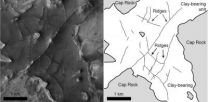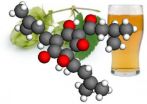(Press-News.org) PROVIDENCE, R.I. [Brown University] — Networks of narrow ridges found in impact craters on Mars appear to be the fossilized remnants of underground cracks through which water once flowed, according to a new analysis by researchers from Brown University.
The study, in press in the journal Geophysical Research Letters, bolsters the idea that the subsurface environment on Mars once had an active hydrology and could be a good place to search for evidence of past life. The research was conducted by Lee Saper, a recent Brown graduate, with Jack Mustard, professor of geological sciences.
The ridges, many of them hundreds of meters in length and a few meters wide, had been noted in previous research, but how they had formed was not known. Saper and Mustard thought they might once have been faults and fractures that formed underground when impact events rattled the planet's crust. Water, if present in the subsurface, would have circulated through the cracks, slowly filling them in with mineral deposits, which would have been harder than the surrounding rocks. As those surrounding rocks eroded away over millions of years, the seams of mineral-hardened material would remain in place, forming the ridges seen today.
To test their hypothesis, Saper and Mustard mapped over 4,000 ridges in two crater-pocked regions on Mars, Nili Fossae and Nilosyrtis. Using high-resolution images from NASA's Mars Reconnaissance Orbiter, the researchers noted the orientations of the ridges and composition of the surrounding rocks.
The orientation data is consistent with the idea that the ridges started out as fractures formed by impact events. A competing hypothesis suggests that these structures may have been sheets of volcanic magma intruding into the surrounding rock, but that doesn't appear to be the case. At Nili Fossae, the orientations are similar to the alignments of large faults related to a mega-scale impact. At Nilosyrtis, where the impact events were smaller in scale, the ridge orientations are associated with each of the small craters in which they were found. "This suggests that fracture formation resulted from the energy of localized impact events and are not associated with regional-scale volcanism," Saper said.
Importantly, Saper and Mustard also found that the ridges exist exclusively in areas where the surrounding rock is rich in iron-magnesium clay, a mineral considered to be a telltale sign that water had once been present in the rocks.
"The association with these hydrated materials suggests there was a water source available," Saper said. "That water would have flowed along the path of least resistance, which in this case would have been these fracture conduits."
As that water flowed, dissolved minerals would have been slowly deposited in the conduits, in much the same way mineral deposits can build up and eventually clog drain pipes. That mineralized material would have been more resistant to erosion than the surrounding rock. And indeed, Saper and Mustard found that these ridges were only found in areas that were heavily eroded, consistent with the notion that these are ancient structures revealed as the weaker surrounding rocks were slowly peeled away by wind.
Taken together, the results suggest the ancient Martian subsurface had flowing water and may have been a habitable environment.
"This gives us a point of observation to say there was enough fracturing and fluid flow in the crust to sustain at least a regionally viable subsurface hydrology," Saper said. "The overarching theme of NASA's planetary exploration has been to follow the water. So if in fact these fractures that turned into these ridges were flowing with hydrothermal fluid, they could have been a viable biosphere."
Saper hopes that the Curiosity rover, currently making its way across its Gale Crater landing site, might be able to shed more light on these types of structures.
"In the site at Gale Crater, there are thought to be mineralized fractures that the rover will go up and touch," Saper said. "These are very small and may not be exactly the same kind of feature we studied, but we'll have the opportunity to crush them up and do chemical analysis on them. That could either bolster our hypothesis or tell us we need to explore other possibilities."
INFORMATION:
The research was supported by a grant from NASA's Rhode Island Space Grant Consortium and through a NASA subcontract with the Applied Physics Lab at Johns Hopkins University.
Editors: Brown University has a fiber link television studio available for domestic and international live and taped interviews, and maintains an ISDN line for radio interviews. For more information, call (401) 863-2476.
Fossilized conduits suggest water flowed beneath Martian Surface
2013-01-29
ELSE PRESS RELEASES FROM THIS DATE:
Researchers find gene that turns up effect of chemotherapy
2013-01-29
Chemotherapy is one of the most common treatments for cancer patients. However, many patients suffer from serious side-effects and a large proportion does not respond to the treatment. Researchers from the Biotech Research and Innovation Centre (BRIC) and Center for Healthy Aging, University of Copenhagen, now show that the gene FBH1 helps turn up the effect of chemotherapy.
"Our results show that the gene FBH1 is crucial in order for some chemotherapeutics to become active in the body and kill the cancer cells. If we can find a feasible method to increase the activity ...
Hydrogen sulfide: The next anti-aging agent?
2013-01-29
Hydrogen sulfide (H2S) may play a wide-ranging role in staving off aging, according to a paper published online ahead of print in the journal Molecular and Cellular Biology. In this review article, a team from China explores the compound's plethora of potential anti-aging pathways.
"H2S has been gaining increasing attention as an important endogenous signaling molecule because of its significant effects on the cardiovascular and nervous systems," the team writes. The evidence is mounting, they note, that hydrogen sulfide slows aging by inhibiting free-radical reactions, ...
New OHSU research helps explain early-onset puberty in females
2013-01-29
BEAVERTON, Ore. - New research from Oregon Health & Science University has provided significant insight into the reasons why early-onset puberty occurs in females. The research, which was conducted at OHSU's Oregon National Primate Research Center, is published in the current early online edition of the journal Nature Neuroscience.
The paper explains how OHSU scientists are investigating the role of epigenetics in the control of puberty. Epigenetics refers to changes in gene activity linked to external factors that do not involve changes to the genetic code itself. The ...
Tomorrow's life-saving medications may currently be living at the bottom of the sea
2013-01-29
PORTLAND, Ore. – OHSU researchers, in partnership with scientists from several other institutions, have published two new research papers that signal how the next class of powerful medications may currently reside at the bottom of the ocean. In both cases, the researchers were focused on ocean-based mollusks – a category of animal that includes snails, clams and squid and their bacterial companions.
Sea life studies aid researchers in several ways, including the development of new medications and biofuels. Because many of these ocean animal species have existed in ...
Beer's bitter compounds could help brew new medicines
2013-01-29
Researchers employing a century-old observational technique have determined the precise configuration of humulones, substances derived from hops that give beer its distinctive flavor.
That might not sound like a big deal to the average brewmaster, but the findings overturn results reported in scientific literature in the last 40 years and could lead to new pharmaceuticals to treat diabetes, some types of cancer and other maladies.
"Now that we have the right results, what happens to the bitter hops in the beer-brewing process makes a lot more sense," said Werner ...
Annals of Internal Medicine early release article for Jan. 29, 2013
2013-01-29
Philadelphia, January 29, 2012 – The Center for Disease Control and Prevention's Advisory Committee on Immunization Practices (ACIP) announced its recommended 2013 adult immunization schedule that includes important updates to the pneumococcal, Tdap (tetanus, diphtheria, and acellular pertussis), and influenza vaccines. Because current vaccination rates are low, ACIP also urges health care providers to regularly assess patient vaccination histories and implement intervention strategies to increase adherence. This recommendation will be published in Annals of Internal Medicine, ...
Study finds significant microorganism populations in middle and upper troposphere
2013-01-29
In what is believed to be the first study of its kind, researchers used genomic techniques to document the presence of significant numbers of living microorganisms – principally bacteria – in the middle and upper troposphere, that section of the atmosphere approximately four to six miles above the Earth's surface.
Whether the microorganisms routinely inhabit this portion of the atmosphere – perhaps living on carbon compounds also found there – or whether they were simply lofted there from the Earth's surface isn't yet known. The finding is of interest to atmospheric scientists, ...
New research uncovers the neural mechanism underlying drug cravings
2013-01-29
Addiction may result from abnormal brain circuitry in the frontal cortex, the part of the brain that controls decision-making. Researchers from the RIKEN Center for Molecular Imaging Science in Japan collaborating with colleagues from the Montreal Neurological Institute of McGill University in Canada report today that the lateral and orbital regions of the frontal cortex interact during the response to a drug-related cue and that aberrant interaction between the two frontal regions may underlie addiction. Their results are published today in the journal Proceedings of ...
Hospital patient loads often at unsafe levels, physician survey says
2013-01-29
Nationwide, more than one-quarter of hospital-based general practitioners who take over for patients' primary care doctors to manage inpatient care say their average patient load exceeds safe levels multiple times per month, according to a new Johns Hopkins study. Moreover, the study found that one in five of these physicians, known as hospitalists, reports that their workload puts patients at risk for serious complications, or even death.
The research, reported in JAMA Internal Medicine, comes as health care systems anticipate an influx of new patients generated by the ...
Researchers find genes behind aggressive endometrial cancer
2013-01-29
New Haven, Conn. — In a major breakthrough for uterine serous carcinoma (USC) — a chemo-resistant, aggressive form of endometrial cancer, Yale researchers have defined the genetic landscape of USC tumors, findings that point to new treatment opportunities.
The collaborative team—which included researchers with expertise in gynecological cancer, genomics, and computational biology— identified a number of new genes that are frequently mutated in USC. The results of this comprehensive genetic analysis of USC are published in the Jan. 28 Proceedings of the National Academy ...


